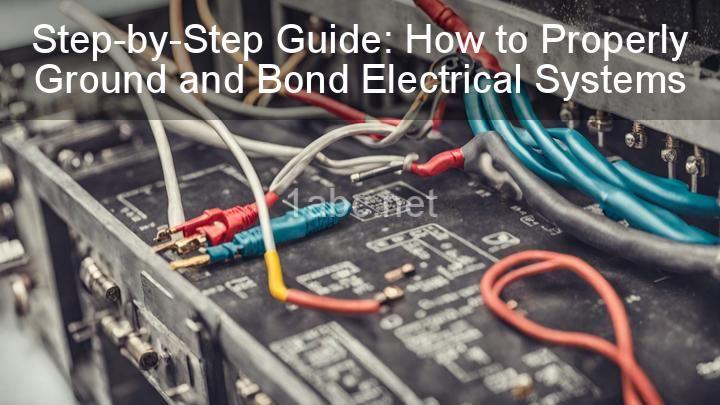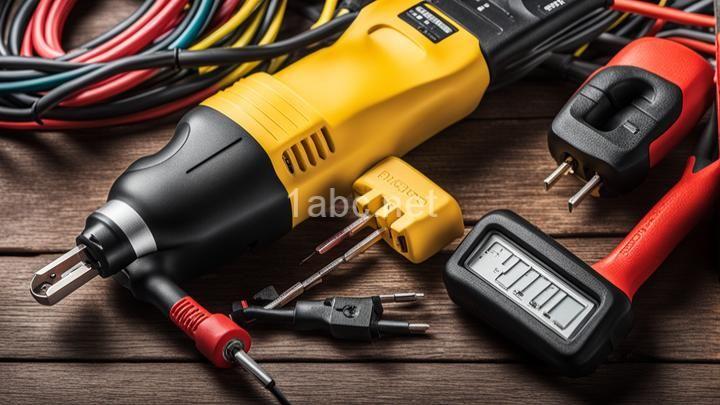Step-by-Step Guide: How to Properly Ground and Bond Electrical Systems

Introduction:Grounding and bonding electrical systems are crucial for ensuring safety. These processes create a path for electrical currents to flow safely into the earth, preventing the risk of electric shock and fires. In this step-by-step guide, we will provide you with a clear understanding of the proper grounding and bonding techniques. By following these instructions, you will be able to protect yourself, your property, and anyone who comes into contact with the electrical system.
I. Understanding Grounding and Bonding:
Grounding involves connecting electrical systems to the earth's conductive surface. It provides a safe path for electrical currents to dissipate harmlessly into the ground. On the other hand, bonding connects various metal components within the electrical system to ensure they are at the same electrical potential. This helps prevent the occurrence of dangerous voltage differences that could cause electrical shock.
Both grounding and bonding are necessary to ensure electrical safety. Grounding protects against electrical shocks, while bonding protects against electrical surges and ensures proper operation of equipment.
II. Identifying Components:
To properly ground and bond an electrical system, you will need several essential components. These include:
- Grounding rods: These are metal rods made of copper or galvanized steel that are driven into the ground. They provide a connection between the electrical system and the earth.
- Grounding conductors: These are copper or aluminum wires that connect the electrical system to the grounding rods. They provide a low-resistance path for electrical currents to flow into the ground.
- Bonding jumpers: These are metal wires or straps that connect metal components within the electrical system together. They ensure that all metal parts are at the same electrical potential.
- Main service panel: This is the central distribution point for electricity in a building. It houses the circuit breakers or fuses and is typically where the grounding and bonding connections are made.
III. Planning the System:
Before starting the installation process, careful planning is essential. Here are some tips to help you assess your electrical system's requirements:
- Determine the correct size of grounding conductors: This can be done by performing load calculations. The size of the grounding conductors should be based on the electrical load of the system to ensure proper grounding.
- Consider the location of grounding rods: The grounding rods should be installed in suitable locations where they can establish a good electrical connection with the earth. Avoid areas with rocky soil or areas prone to flooding.
IV. Installing Grounding Rods:
Proper installation of grounding rods is crucial for establishing an effective grounding system. Follow these steps:
- Select suitable locations: Choose locations for driving in the grounding rods that meet the requirements of local electrical codes. The rods should be spaced apart adequately and positioned away from any existing utilities or structures.
- Install the rods: Use a grounding rod driver or sledgehammer to drive the rods into the ground. Ensure that at least 8 feet of the rod is buried in the earth to achieve a good electrical connection. If necessary, install multiple grounding rods, interconnected with grounding conductors, to improve grounding effectiveness.
V. Connecting Grounding Conductors:
Connecting grounding conductors to various components within the electrical system is vital for proper grounding. Follow these instructions for different types of connections:
- Outlets: Connect a grounding conductor to the grounding screw on the outlet. This conductor should be connected to the grounding system, such as the main service panel or a grounding bus bar.
- Appliances: Many appliances come with a grounding conductor. Connect this conductor to the grounding screw or terminal on the appliance. Ensure that the other end of the conductor is connected to the grounding system.
- Electrical panels: Connect the grounding conductor to the grounding bus bar in the main service panel. This bus bar should be bonded to the grounding electrode system, which includes the grounding rods.
VI. Establishing Bonding Connections:
Establishing bonding connections between different metal parts within the electrical system is crucial for safety. Follow these steps:
- Bonding metallic conduits: Use bonding jumpers to connect metallic conduits together. This ensures that all metal parts are at the same electrical potential and can safely carry fault currents.
- Bonding enclosures: Connect metal enclosures, such as junction boxes or switch boxes, to the grounding system using bonding jumpers. This provides a low-resistance path for fault currents.
- Bonding equipment: Connect metal equipment, such as motors or generators, to the grounding system using bonding jumpers. This ensures that any fault currents are safely directed to the ground.
VII. Verifying Effectiveness:
Once the installation is completed, it is essential to verify the effectiveness of the grounding and bonding system. Testing tools can help ensure that the connections are made correctly and that the system is properly grounded. Some recommended testing tools include:
- Ground resistance testers: These measure the resistance of the grounding system to ensure it is within acceptable limits.
- Continuity testers: These check the continuity of bonding connections to ensure they are properly established.
Conclusion:
Proper grounding and bonding of electrical systems are essential for safety. By understanding the differences between grounding and bonding, identifying the necessary components, planning the system, and following the step-by-step instructions for installation, you can ensure the safety of your electrical system. Remember to always prioritize safety when working with electricity and consult a qualified electrician if you are unsure or lack the necessary expertise.
FREQUENTLY ASKED QUESTIONS
What is the importance of grounding and bonding electrical systems?
Grounding and bonding are essential for electrical systems due to the following reasons:
- Safety: Grounding helps protect people from electric shock by providing a direct path for electrical fault currents to flow into the ground rather than through a person's body. When a fault occurs, the grounding system ensures that excessive voltage does not build up, reducing the risk of injury or electrocution.
- Equipment Protection: Proper grounding and bonding help protect electrical equipment from damage caused by electrical faults, lightning strikes, or power surges. Grounding allows fault currents to be quickly diverted away from sensitive equipment, preventing damage and extending the lifespan of the devices.
- Surge Suppression: Grounding also plays a crucial role in mitigating electrical surges and transient voltages. By providing a low-resistance path to ground, excess voltage generated by lightning or switching operations can be safely discharged, preventing damage to equipment and minimizing the risk of fire.
- Equipment Performance and Stability: Effective grounding and bonding improve the performance and reliability of electrical systems. It helps reduce electromagnetic interference (EMI) by providing a reference point for electrical currents and minimizing the risk of signal distortion. Proper grounding can also stabilize voltage levels, ensuring the consistent operation of appliances and electronics.
- Compliance with Codes and Standards: Grounding and bonding are mandatory requirements in electrical codes and standards. By complying with these regulations, electrical systems adhere to safety guidelines and are less likely to cause electrical hazards, ensuring the well-being of users and preventing legal and financial consequences.
Overall, grounding and bonding are crucial practices to ensure both the safety of individuals and the proper functioning of electrical systems, protecting people, equipment, and buildings from electrical hazards and malfunctions.
How does grounding protect against electrical hazards?
Grounding is an essential safety measure that helps protect against electrical hazards. It involves connecting electrical equipment and wiring to the ground or Earth. Here's how grounding works to enhance safety:
- Prevents electrical shocks: When an electrical fault occurs, such as a short circuit or a malfunctioning appliance, current can flow through metal components. If these components are not grounded, they can become energized and pose a risk of electric shock to anyone who touches them. Grounding provides a low-resistance path for the fault current to flow safely into the ground instead, minimizing the chances of injury.
- Diverts excess current: In the event of a surge or sudden increase in electrical current, grounding provides a path for the excess current to flow into the ground. This helps prevent damage to electrical equipment and reduces the risk of electrical fires by allowing the circuit breaker or fuse to quickly interrupt the excessive current flow.
- Improves system stability: Grounding helps stabilize electrical systems by providing a reference point for voltages. It helps to maintain a balanced voltage level throughout electrical circuits by allowing excess current to flow to the ground. This prevents voltage fluctuations that could cause damage to sensitive equipment or disrupt the normal functioning of electrical systems.
- Protects against lightning strikes: Grounding is crucial for protecting buildings and structures from lightning strikes. Lightning carries an immense amount of electrical energy, and without proper grounding, it can cause severe damage by following alternative paths, such as electrical wiring or metal pipes. Grounding systems safely direct lightning strikes into the ground, preventing them from causing harm.
Overall, grounding is a critical safety measure that safeguards against electrical hazards by preventing electric shocks, diverting excess current, improving system stability, and protecting against lightning strikes.
What are the potential risks of not properly grounding an electrical system?
Not properly grounding an electrical system can lead to several potential risks, including:
- Electric shock: If an electrical system is not properly grounded, it increases the risk of electric shock to individuals using the system. In the event of a fault or malfunction, excess electrical current may flow through equipment or metal surfaces, posing a risk to anyone who comes into contact with them.
- Fire hazard: Without adequate grounding, electrical equipment and appliances may experience increased heat buildup due to electrical faults, overloads, or short circuits. This can potentially lead to fire hazards, as overheating can cause insulation to melt and ignite nearby combustible materials.
- Equipment damage: Electrical surges or transient voltages can occur due to lightning strikes, power outages, or electrical malfunctions. Without proper grounding, these surges have no safe path to disperse, resulting in potential damage to electrical equipment, including computers, appliances, and other sensitive electronics.
- Malfunctioning of sensitive electronics: Many modern electronic devices require a proper grounding connection to function correctly. Without grounding, these devices may malfunction or experience performance issues, leading to data loss, operational errors, or shortened lifespan.
- Interference and noise: Inadequate grounding can cause electromagnetic interference (EMI) and radio frequency interference (RFI) in communication systems. This interference can disrupt the functionality of nearby electronic devices, leading to poor signal quality, disrupted communication, or data transmission errors.
To ensure safety and protect equipment, it is essential to follow proper grounding practices as recommended by national and local electrical codes. It is advised to consult a licensed electrician for assistance with any electrical system installations or modifications.



